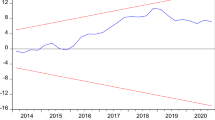Abstract
The Mexican Peso Crisis was the byproduct of various developments including large inflows of short-term foreign capital, prolonged current account deficit, and political instability. Between 1990 and 1993, investors in the United States were particularly eager to provide loans, many of them short-term, to the Mexican government and to Mexican corporations. Throughout this period, the share of foreign capital inflows exceeded the current account deficit. However, political instability and U.S. interest rate hikes soon changed the optimism for Mexico’s economic outlook. At the beginning of 1994, this did not affect the value of the peso, for Mexico was operating with a target zone exchange rate and its central bank stood ready to accept pesos and pay out dollars at the fixed rate. Yet Mexico’s reserves of foreign currency were too small to maintain its target zone exchange rate. When Mexico ran out of dollars at the end of 1994, the Mexican government announced a devaluation of the peso. As a result, investors avoided buying Mexican assets, adding to downward pressure on the peso.
Overall, the Mexican meltdown of 1994–1995 had many facets. Yet couple of lessons are particularly clear: while foreign capital can make up for the shortfall in domestic saving, only long-term capital – in the forms of foreign direct investment or long-term debt – is conducive to domestic investment; large and abrupt movements of capital across national borders can cause excessive financial market volatility and undermine economic stability in the countries involved. Last and most importantly, prolonged current account deficit should be remedied by allowing the domestic currency to depreciate, promoting savings, or cutting back government expenditure rather than financed by foreign capital inflows. Countries with protracted current account deficits such as Argentina, the Philippines, Indonesia, Thailand, and Saudi Arabia, with Thailand in particular, should heed Mexico’s experience.
Access this chapter
Tax calculation will be finalised at checkout
Purchases are for personal use only
Similar content being viewed by others
Author information
Authors and Affiliations
Editor information
Editors and Affiliations
Rights and permissions
Copyright information
© 2022 Springer Nature Switzerland AG
About this entry
Cite this entry
Perng, FN. (2022). The Mexican Peso Crisis. In: Lee, CF., Lee, A.C. (eds) Encyclopedia of Finance. Springer, Cham. https://doi.org/10.1007/978-3-030-91231-4_34
Download citation
DOI: https://doi.org/10.1007/978-3-030-91231-4_34
Published:
Publisher Name: Springer, Cham
Print ISBN: 978-3-030-91230-7
Online ISBN: 978-3-030-91231-4
eBook Packages: Economics and FinanceReference Module Humanities and Social SciencesReference Module Business, Economics and Social Sciences




